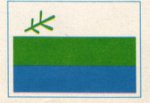
Labrador
|
Labrador |
|
In spite of prolonged and relatively severe winters, few Labrador animals actually hibernate, coping instead by complete adaptation or extended sleep during cold snaps. While the myopic, rather lazy but dangerous black bear (dangerous because he IS lazy and will raid camps rather than hunt) sleeps much of the winter away, the keen-eyed polar bear is searching the ice for seals. Moose are found from central Labrador southward, munching on tree leaves in the summer and fall and in meadow clearings in winter as they trample the snow to get at the grass and wild plants. The forest habitat also includes the elusive lynx and wolverine, as well as wolves, porcupine, flying and red squirrels, beaver, muskrat, otter. martin, ermine and mink, easily observed while hiking, canoeing, skiing and snowshoeing. Surprisingly, you will find plants like rhododendron on the tundra, but unlike its 12 m (40') high showy blossomed relative in the south, you almost have to be on your hands and knees to find its gnarled, ground-hugging branches and tiny but recognizable, aromatic purple flowers. And so it is with Arctic species of poppies, heather, butter cups, fireweed, violets, ferns, birch and willow, to name a few. While trees such as poplar,juniper,tamarack and birch occur throughout the forest, all but the black spruce disappear before reaching the critical taiga 'tree line.' The spruce will grow from 27 m (90') in favourable conditions to a twisted and bent tree less than a metre high in the taiga. As if in defiance of the light carpet of caribou 'moss' (lichen) which often prevents seeds from reaching the ground, the spruce will root from its lower branches, resembling a candleabra. Labrador is a rich environment for about 90 species of nesting birds which can be found in trees, on the ground and on rocky ledges. Whatever resources it takes to reach the crowded, noisy bird colonies on the tiny islands doffed along the coast it will be worthwhile and an experience you won't soon forget. The permanent bird residents of the region include species of owls, woodpeckers, ravens, ducks, gyrfalcon, jay, chickadee, grouse, ptar-migan, nuthatch, siskin and crossbill,adding life to the quiet winter landscape. A close inspection of the almost fearless ptarmigan will reveal feathered feet and legs, a marvelous adaptation to Labrador winter. The land, sea and skies of Labrador team with hundreds of species of wildlife in motion. How birds find their nesting grounds from thousands of kilometres away; or caribou locate their small calving ground over hundreds of kilometres of rough terrain; or salmon find the river in which they were hatched from hundreds of kilometres out at sea, is a miracle of navigation that can only be guessed at. In Labrador you can take the time to learn from the natural world around you and to participate in a magnificent and unspoiled part of this planet.
Note: If you encounter a wild animal keep calm, do not run and never corner an animal. keep your camp clean, avoid food with strong odours, store food in airtight containers away from your sleeping area and burn all refuse. Although attacks are rare, bears and moose are unpredictable and may be dangerous |
||||